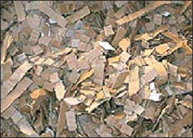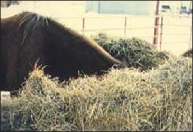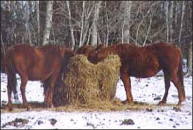Asthma (Heaves) in Horses
Asthma (Heaves) in Horses
Author: Fernanda C. Camargo
Introduction
Recurrent Airway Obstruction (RAO or heaves) is an allergic, inflammatory, and obstructive airway disease that afflicts older horses. RAO used to be called COPD, or Chronic Obstructive Pulmonary Disease, but in 2000 the name was changed to RAO, or simply "heaves." The condition is similar to human asthma.
Heaves is a syndrome more common when horses are stabled and fed hay. Heaves may be initiated by the inhalation of organic dusts, such as those associated with hay and bedding materials. Such organic dusts contain allergens, endotoxins, molds, and other small particles and substances that can start the severe inflammation of the lungs associated with heaves. Not all horses stabled and fed hay will develop heaves; there seems to be a genetic predisposition for the condition. Heaves-affected horses are prone to develop bronchospasm (narrowing of airways) in response to levels of stimuli that would not affect a normal horse. Good quality hay has enough dust particles to trigger an episode in a heaves-prone horse but should not be of any danger to horses without the condition.
Development of Heaves
When predisposed horses are moved from pasture to stable and fed hay, airway inflammation develops in as little as 6 to 8 hours. Airway obstruction happens as a result of bronchospasm, mucus accumulation, and airway wall thickening (also called remodeling). Mucus becomes more viscous, and mucus production is increased. Airway walls thicken as an acute response, with signs of edema or swelling of the airways, or chronically, due to airway remodeling. Remodeling is a result of the repeated bouts of heaves and repetitive injury to the pulmonary tract. The horse develops airway smooth muscle hypertrophy, in which the muscle itself Second, the horse's diet should be changed becomes thicker, and there is deposition of fi brous tissue around the airways, decreasing the elasticity of the lungs.
The airways of heaves-affected horses narrow in an exaggerated manner in response to stimulus (allergens, dust, irritant odors, etc.). This condition is called hyperresponsiveness; it is more pronounced during acute heaves episodes, and it wanes when animals are out on pasture. Even a brief exposure of a heaves-affected horse to a stable environment can induce hyperresponsiveness that lasts for days.
Clinical Signs

Severe Cases. The clinical signs of a severely affected horse are easy to recognize, appearing as marked respiratory distress. Generally the horse is 7 years of age or older and has spent a
considerable period of its life stabled and fed hay. In horses undergoing a severe acute episode, the nostrils are flared, the respiratory rate is increased, the horse is using its abdominal muscles to assist expiration, and the animal has an anxious appearance and/or is agitated. The horse may have nasal discharge. It becomes increasingly intolerant to exercise, and the chronic use of the abdominal muscles to assist expiration leads to the development and appearance of "heave lines" (Figure 1). In severe stages of the disease, wheezing can be heard, and the struggle to breathe is so intense that the horse is unable to eat and consequently loses weight.
Mild Cases. Clinical signs in less severely affected horses include coughing associated with exercise or during feeding or cleaning/sweeping the barn, reduced exercise tolerance, and delayed recovery from exercise. If not managed properly, a mild case of heaves will progress to a severe case over time.
Diagnosis
The diagnosis of heaves is generally based on history and clinical signs. The severity of lung inflammation can be evaluated by cytological evaluation of bronchoalveolar lavage fluid (BALF).
This is a technique that only your veterinarian can perform. Radiographs or ultrasound of the lungs can be useful to rule out other types of lung diseases. Your veterinarian will make the definitive diagnosis.
Management and Prevention

The many management practices recommended for treating or controlling heaves include first a change in the horse's environment to eliminate dust exposure. The best environment is to be at pasture (not a dry lot), but if this is not possible, the horse should be moved to a place in the barn where airborne particles and allergens are fewer. Supportive strategies include improving the ventilation system of the barn, changing general management practices performed inside the barn—such as avoiding the storage of hay in the barn loft, and avoiding constant sweeping ofthe floor, a practice that keeps particles suspended in the air for longer periods of time. When horses are confined to the barn, the bedding should also be changed to one that produces the least amount of dust, such as chopped paper or cardboard (Figure 2).
 |
 |
Figure 3. Note how horses bury their heads in the round bales. This causes them to breathe in allergens and particulates, which is sufficient to a heaves attack in a heaves-affected horse.
Second, the horse's diet should be changed to one that contains low amounts of dust. This managerial practice goes together with changing the environment to pasture, as discussed above. When horses are out in pasture year-round, they have access, during the summer, to the best diet a horse needs. During winter, when grass is low, pelleted food should be provided. Hay should beavoided at all times, especially round baled hay. Rolled grains, which have a high dust content, should also be avoided.
If cutting hay from the diet is not possible, soak hay in water for about 5 minutes before feeding. Sprinkling hay with water is not the same as soaking hay in water. Sprinkling hay with water is
not an effective way to eliminate the dust content of the hay, and thus will not do much for the horse with heaves.
Silage, alfalfa pellets, alfalfa cubes, and whole grains have low amounts of dust. When feeding silage to horses, consider the risk of botulism, since horses are more susceptible to this devastating disease than cattle. This approach is especially important here in Kentucky, where botulism is endemic, which means it is everywhere. If feeding silage to horses, consider vaccinating them against botulism.
Third, because a clinical characteristic of heaves is a substantial amount of inflammation in the respiratory tract, your veterinarian may prescribe medications as part of the treatment. These medications include anti-inflammatory agents. Of these agents, corticosteroids are more effective and are more widely used than the non-steroidal anti-inflammatory drugs such as Flunixin Meglumine. Corticosteroids are more effective because they combat the inflammatory response while causing some bronchodilation (opening of the airways) and an increase in appetite. The effects are particularly favorable as the disease becomes more severe and the horses eat less due to the difficulty in breathing. This class of medications can only be prescribed by your veterinarian. Some of the corticosteroids used are Dexamethasone (intravenous medication), which improves lung function dramatically within 1 week; Prednisolone (oral medication); Beclomethasone (aerosolized medication); and Fluticasone (aerosolized).
To avoid the systemic side-effects associated with long-term corticosteroid use, the dose of corticosteroids needs to be reduced gradually once control of the disease has been achieved. If the horse will be on long-term corticosteroid therapy, it is better to choose the aerosolized medications. If parenteral medications (such as intravenous or intramuscular administrations) are needed, it is better to maintain horses on alternate-day therapy to avoid side effects related to corticosteroids. It may not be useful to start treatment with an aerosolized corticosteroid, because the severity of the airway obstruction prevents the deposition of the inhaled medication into the lungs.
Last, in the case of an acute heaves attack, the administration of bronchodilators is recommended. Bronchodilators can be administered orally, intravenously, or via aerosol, depending on the agent and the formulation. For an agent to be a safe and effective bronchodilator in horses it should: 1) cause an effective bronchodilation, 2) produce few or no side effects, and 3) rapidly alleviate any apparent distress the horse may be suffering. Bronchodilators relax the airway smooth muscle, "opening" the airways, and thereby relieving some of the respiratory distress. Because bronchodilators do not treat the airway inflammation, they are essentially "rescue medications" and should not be solely relied upon, especially if the other three measures mentioned above are not being used. Some of the bronchodilators include Clenbuterol (oral), Albuterol (aerosol), Salmeterol (aerosol), and Ipratropium (aerosol). But again, these medications can only be prescribed by your veterinarian. One practical use for aerosolized bronchodilators is for "opening" the airways 15 minutes prior to administering aerosolized corticosteroids.
|
Take Home Message RAO, or heaves, is a chronic disease that will require a life-long change in the management of the horse. The earlier that heaves is recognized and diagnosed, and the more rigorously the horse's environment is changed as to avoid recurring episodes of heaves |
References
Broadstone, R. S. (1988). Effects of atropine in ponies with recurrent airway obstruction. Journal of Applied Physiology, 65 (6), 2720-2725.
Derksen, F. S. (1985). Bronchoalveolar lavage in ponies with recurrent airway obstruction (heaves). The American Review of Respiratory Disease, 132 (5), 1066-1070.
Fairbairn, S. P. (1993). Early neutrophil but not eosinophil or platelet recruitment to the lungs of allergic horses following antigen exposure. Clinical and Experimental Allergy, 23, 821-828.
Gerber, V. K. (2000). Tracheobronchial mucus viscoelasticity during environmental challenge in horses with recurrent airway obstruction. Equine Veterinary Journal, 32 (5), 411-417.
Knottenbelt, Derek C., and Reg R. Pascoe, ed. (1994). Color atlas of diseases and disorders of the horse. Amsterdam: Elsevier, page 108.
McGorum, B. E. (1998). Total and respirable airborne dust endotoxin concentrations in three equine management systems. Equine Veterinary Journal, 30, 430-434.
Robinson, N. K. (2006). Airway infl ammation in Michigan pleasure horses: prevalence and risk factors. Equine Veterinary Journal, 38 (4), 293-299.
Robinson, N. (2001). Recurrent Airway Obstruction (Heaves). In P. Lekeux, Equine Respiratory Diseases. Ithaca, N.Y.: IVIS, International Veterinary Information Service (www.ivis.org).
Woods, P. R. (1993). Airborne dust and aeroallergen concentration in a horse stable under two different management systems. Equine Veterinary Journal, 25 (3), 208-213.
